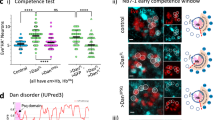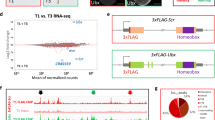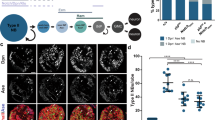Abstract
Notch and the m9/10 gene (groucho) of the Enhancer of split (E(spl)) complex are members of the “Notch group” of genes, which is required for a variety of cell fate choices in Drosophila. We have characterized human cDNA clones encoding a family of proteins, designated TLE, that are homologous to the E(spl) m9/10 gene product, as well as a novel Notch–related protein. The TLE genes are differentially expressed and encode nuclear proteins, consistent with the presence of sequence motifs associated with nuclear functions. The structural redundancy implied by the existence of more than one TLE and Notch–homologous gene may be a feature of the human counterparts of the developmentally important Drosophila Notch group genes.
This is a preview of subscription content, access via your institution
Access options
Subscribe to this journal
Receive 12 print issues and online access
$209.00 per year
only $17.42 per issue
Buy this article
- Purchase on SpringerLink
- Instant access to full article PDF
Prices may be subject to local taxes which are calculated during checkout
Similar content being viewed by others
References
Artavanis-Tsakonas, S. & Simpson, P. Choosing a cell fate: a view from the Notch locus. Trends Genet. 7, 403–408 (1991).
Wharton, K.A., Johansen, K.M., Xu, T. & Artavanis-Tsakonas, S. Nucleotide sequence from the neurogenic locus Notch implies a gene product that shares homology with proteins containing EGF-like repeats. Cell 43, 567–581 (1985).
Kidd, S., Kelley, M.R. & Young, M.W. Sequence of the Notch locus of D. melanogaster: relationship of the encoded protein to mammalian clotting and growth factors. Molec. cell. Biol. 6, 3094–3108 (1986).
Vaessin, H., Vielmetter, J. & Campos-Ortega, J.A. Genetic interactions in early neurogenesis of Drosophila melanogaster. J. Neurogenet. 2, 291–308 (1985).
Fehon, R.G. et al. Molecular interactions between the protein products of the nuerogenic loci Notch and Delta, two EGF-homologous genes in Drosophila. Cell 61, 523–534 (1990).
Fleming, R.J., Scottgale, T.N., Diederich, R.J. & Artavanis-Tsakonas, S. The gene Serrate encodes a putative EGF-like transmembrane protein essential for proper ectodermal development in Drosophila melanogaster. Genes Devl. 4, 2188–2201 (1990).
Xu, T., Rebay, I., Fleming, R.J., Scottgale, N. & Artavanis-Tsakonas, S. The Notch locus and the genetic circuitry involved in early Drosophila neurogenesis. Genes Dev. 4, 464–475 (1990).
Rebay, I. et al. Specific EGF repeats of Notch mediate interactions with Delta and Serrate: implications for Notch as a multifunctional receptor. Cell 67, 687–699 (1991).
Thomas, U., Speicher, S.A. & Knust, E. The Drosophila gene Serrate encodes an EGF-like transmembrane protein with a complex expression pattern in embryos and wing discs. Development 111, 749–761 (1991).
Xu, T. & Artavanis-Tsakonas, S. deltex, a locus interacting with the neurogenic genes, Notch, Delta, and mastermind in Drosophila melanogaster. Genetics 126, 665–677 (1991).
Knust, E., Tietze, K. & Campos-Ortega, J.A. Molecular analysis of the neurogenic locus Enhancer of split of Drosophila melanogaster. EMBO J. 6, 4113–4123 (1987).
Hartley, D.A., Preiss, A. & Artavanis-Tsakonas, S. A deduced gene product from the Drosophila neurogenic locus, Enhancer of split, shows homology to mammalian G protein β subunits. Cell 55, 785–795 (1988).
Preiss, A., Hartley, D.A. & Artavanis-Tsakonas, S. The molecular genetics of Enhancer of split, a gene required for embryonic neural development in Drosophila. EMBO J. 7, 3917–3927 (1988).
Klambt, C., Knust, E., Tietze, K. & Campos-Ortega, J.A. Closely related transcripts encoded by the neurogenic gene complex Enhancer of split of Drosophila melanogaster. EMBO J. 8, 203–210 (1989).
Smoller, D. et al. The Drosophila neurogenic locus mastermind encodes a nuclear protein unusually rich in amino acid homopolymers. Genes Dev. 4, 1688–1700 (1990).
Delidakis, C., Preiss, A., Hartley, D.A. & Artavanis-Tsakonas, S. Two genetically and molecularly distinct functions involved in early neurogenesis reside within the Enhancer of split locus of Drosophila melanogaster. Genetics 129, 803–823 (1991).
Coffman, C., Harris, W. & Kintner, C. Xotch, the Xenopus homolog of Drosophila Notch. Science 249, 1438–1441 (1990).
Ellisen, L. et al. TAN-1, the human homolog of the Drosophila Notch gene, is broken by chromosomal translations in T lymphoblastic neoplasms. Cell 66, 649–661 (1991).
Weinmaster, G., Roberts, V.J. & Lemke, G. A homolog of Drosophila Notch expressed during mammalian development. Development 113, 199–205 (1991).
Fehon, R.G., Johansen, K., Rebay, I. & Artavanis-Tsakonas, S. Complex cellular and subcellular regulation of Notch expression during embryonic and imaginal development of Drosophila: implications for Notch function. J. cell Biol. 113, 657–669 (1991).
Jans, D.A., Ackermann, M.J., Bischoff, J.R., Beach, D.H. & Peters, R. p34cdc2-mediated phosphorylation at T124 inhibits nuclear import of SV-40 T antigen proteins. J. cell Biol. 115, 1203–1212 (1991).
Simon, M.I., Strathmann, M.P. & Gautam, N. Diversity of G proteins in signal transduction. Science 252, 802–808 (1991).
Adams, M.D. et al. Complementary DNA sequencing: expressed sequence tags and human genome project. Science 252, 1651–1656 (1991).
Rihs, H.P., Jans, D.A., Fan, H. & Peters, R. The rate of nuclear cytoplasmic protein transport is determined by the casein kinase II site flanking the nuclear localization sequence of the SV 40 T-antigen. EMBO J. 10, 633–639 (1991).
Kalderon, D., Richardson, W.D., Markham, A.F. & Smith, A.E. Sequence requirements for nuclear location of simian virus 40 large-T antigen. Nature 311, 499–509 (1984).
Dingwall, C. & Laskey, R.A. Nuclear targeting sequences- a consensus? Trends Biochem. Sci. 16, 478–481 (1991).
Meisner, H. & Czech, M.P. Phosphorylation of transcriptional factors and cell-cycle dependent proteins by casein kinase II. Curr. Opin. Cell Biol. 3, 474–483 (1991).
Moreno, S. & Nurse, P. Substrates for p34cdc2: in vivo veritas? Cell 61, 549–551 (1990).
Williams, F.E. & Trumbly, R.J. Characterization of TUP1, a mediator of glucose repression in Saccharomyces cerevisiae. Molec. cell Biol. 10, 6500–6511 (1990).
Smith, D.B. & Johnson, K.S. Single-step purification of polypeptides expressed in Eschehchia coli as fusions with glutathione S-transferase. Gene 67, 31–40 (1988).
Rogers, S., Wells, R. & Rechsteiner, M. Amino acid sequences common to rapidly degraded proteins: the PEST hypothesis. Science 234, 364–368 (1986).
Yochem, J. & Byers, B. Structural comparison of the yeast cell division cycle gene CDC4 and a related pseudogene. J. molec. Biol. 195, 233–245 (1987).
Dalrymple, M.A., Petersen-Bjorn, S., Friesen, J.D. & Beggs, J.D. The product of the PRP4 gene of S. cerevisiae shows homology to β subunits of G proteins. Cell 58, 811–812 (1989).
Ruggieri, R. et al. MS11, a negative regulator of the RAS-cAMP pathway in Saccharomyces cerevisiae. Proc. natn. Acad. Sci. U.S.A. 86, 8778–8782 (1989).
Guillemat, F., Billault, A. & Auffray, C. Physical linkage of a guanine nucleotide-binding protein-related gene to the chicken major histocompatibility complex. Proc. natn. Acad. Sci. U.S.A. 86, 4594–4598 (1989).
Goebl, M. & Yanagida, M. The TPR snap helix repeat: a novel protein repeat motif from mitosis to transcription. Trends Biochem. Sci. 16, 173–177 (1991).
Williams, F.E., Varanasi, U. & Trumbly, R.J. The CYC8 and TUP1 proteins involved in glucose repression in Saccharomyces cerevisiae are associated in a protein complex. Molec cell. Biol. 11, 3307–3316 (1991).
Aves, S.J., Durkacz, B.W., Carr, A. & Nurse, P. Cloning, sequencing and transcriptional control of the Schizosaccharomyces pombe cdc10 “start” gene. EMBO J. 4, 457–463 (1985).
Breeden, L. & Nasmyth, K. Similarity between cell-cycle genes of budding yeast and fission yeast and the Notch gene of Drosophila. Nature 329, 651–654 (1987).
Ghosh, S. et al. Cloning of the p50 DNA binding subunit of NF-kB: homology to rel and dorsal. Cell 62, 1019–1029 (1990).
La Marco, K., Thompson, C.C., Byers, B.P., Walton, E.M. & McKnight, S.L. Identification of ETS- and Notch-related subunits in GA binding protein. Science 253, 789–792 (1991).
Haskill, S. et al. Characterization of an immediate-early gene induced in adherent monocytes that encodes 1kB-like activity. Cell 65, 1281–1289 (1991).
Thompson, C.C., Brown, T.A. & McKnight, S.L. Convergence of Ets- and Notch-related structural motifs in a heteromeric DNA binding complex. Science 253, 762–768 (1991).
Stifani, S., George, R. & Schneider, W.J. Solubilization and characterization of the chicken oocyte vitellogenin receptor. Biochem. J. 250, 467–475 (1988).
Sambrook, J., Fritsch, E.F. & Maniatis, T. Molecular cloning: a laboratory manual. (eds Ford N. et al.)(Cold Spring Harbour Laboratory Press, Cold Spring Harbour, 1989).
McVey, D. et al. Phosphorylation of large tumor antigen by cdc2 stimulates SV 40 DNA replication. Nature 341, 503–507 (1989).
Dang, C.V. & Lee, W.M. Identification of the human c-myc protein nuclear translocation signal. Molec. cell. Biol. 8, 4048–4054 (1988).
Jenkins, J., Rudge, K. & Currie, G. Cellular immortalization by a cDNA clone encoding the transformation associated phosphoprotein p53. Nature 312, 651–654 (1984).
Nomura, N. et al. Isolation of human cDNA clones of myb-related genes, A-myb and B-myb. Nucl. Acids Res. 16, 11075–11089 (1988).
Luscher, B., Christenson, E., Litchfield, D., Krebs, E. & Eisenman, R. Myb DNA binding inhibited by phosphorylation at a site deleted during oncogenic activation. Nature 344, 517–522 (1990).
Steward, R. dorsal, an embryonic polarity gene in Drosophila, is homologous to the vertebrate proto-oncogene, c-rel. Science 238, 692–694 (1987).
Grasser, F.A., Scheidtman, K.H., Tuazon, P.T., Traugh, J.A. & Walter, G. In vitro phosphorylation of SV 40 large T antigen. Virology 165, 13–22 (1988).
Luscher, B., Kuenzel, E.A., Krebs, E.G. & Eisenman, R.N. Myc oncoproteins are phosphorylated by casein kinase II. EMBO J. 8, 1111–1119 (1989).
Bischoff, J.R., Friedman, P.N., Marshak, D.R., Prives, C. & Beach, D. Human p53 is phosphorylated by p60-cdc2 and cyclin-cdc2. Proc. natn. Acad. Sci. U.S.A. 87, 4766–4770 (1990).
Meek, D.W., Simon, S., Kikkawa, U. & Eckart, W. The p53 tumor suppressor protein is phosphorylated at serine 389 by casein kinase II. EMBO J. 9, 3253–3260 (1990).
Author information
Authors and Affiliations
Rights and permissions
About this article
Cite this article
Stifani, S., Blaumueller, C., Redhead, N. et al. Human homologs of a Drosophila Enhancer of Split gene product define a novel family of nuclear proteins. Nat Genet 2, 119–127 (1992). https://doi.org/10.1038/ng1092-119
Received:
Accepted:
Issue Date:
DOI: https://doi.org/10.1038/ng1092-119



